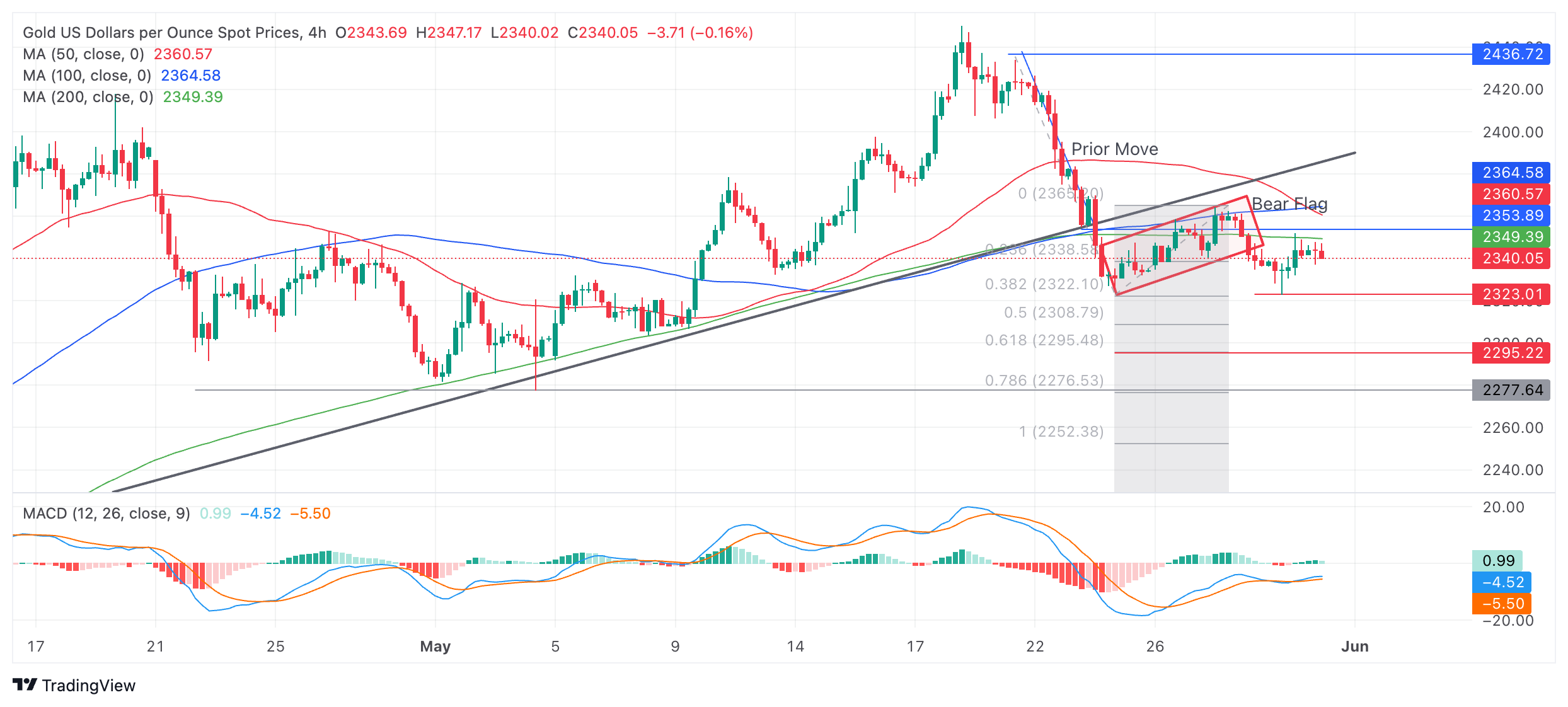- Gold extends its recovery after PCE inflation data showed easing price pressures in April.
- Gold had already gained following the second estimate of US first quarter GDP data, which showed the economy expanded less than previously anticipated.
- Gold remains technically vulnerable after a breakout of the bearish flag continuation pattern.
Gold (XAU/USD) is trading higher, rising to $2,350 on Friday after the publication of US personal consumption expenditure (PCE) price index data for April, which showed a decline in underlying price pressures. PCE is the Federal Reserve's (Fed) preferred inflation gauge and core PCE cooled to 0.2% month-on-month, from 0.3% previously, according to data from the Bureau of Economic Analysis. Analysts expected core PCE to remain unchanged at 0.3%.
The rest of the PCE data was in line with analyst estimates, however, the decline in core PCE suggests that inflation could be cooling more quickly than previously thought in the US, and that, as Consequently, the probability that the Fed will reduce interest rates increases. Lower interest rates tend to be positive for Gold as they reduce the opportunity cost of holding the non-yielding asset.
The gains follow a rally that began on Thursday after the release of weaker U.S. growth data, suggesting inflation would remain subdued, which also led to lower interest rate projections.
Gold recovers after slowing growth in the US
Gold rallied on Thursday after the second estimate of US first-quarter GDP growth showed a downward revision to 1.3% annualized from 1.6% in the first estimate.
The slower growth came from lower consumer spending, which in turn is expected to keep inflation contained and the Federal Reserve (Fed) on track to lower interest rates. Reflecting changing expectations after the GDP release, the 10-year US Treasury yield fell to 4.55% from a four-week high of 4.63%.
Markets have been considering the possibility that the Fed might even raise interest rates. However, comments from several Fed officials on Thursday ruled out this idea:
- Atlanta Fed President Raphael Bostic noticed that he did not believe further rate increases were required to meet the Fed's 2.0% annual inflation target.
- Chicago Fed President Austan Goolsbee noticed that although housing inflation remained “very high”, making it difficult to reach 2.0%, he was “optimistic that housing inflation will decrease.”
- New York Fed President John Williams said who believed Fed policy was well positioned to slowly bring price growth back to the Fed's 2.0% annual target.
US Personal Consumption Expenditure (PCE) Price Index data for April, due to be released on Friday, could further impact interest rate expectations, in turn influencing the price of Gold. PCE is the Fed's preferred inflation indicator, so it tends to carry more weight. Although, as several analysts have pointed out, the publication is quite predictable, since it occurs after the CPI and PPI data of the same month. That said, small deviations from expectations could still lead to volatility.
The odds of the Fed cutting interest rates before September are negligible and are at a 50/50 balance in September, according to data from the CME FedWatch tool.
Gold and Asian demand as a currency hedge
Interest rate expectations in the US are not the only factor influencing the price of Gold, according to Daniel Ghali, Senior Commodities Strategist at TD Securities.
Ghali's research shows that gold demand is being driven by Asian buyers who are hoarding the precious metal as a hedge as their currencies depreciate against a strengthening US dollar (USD).
“Precious metals are acting as a hedge against currency depreciation. Case in point: fund flows into Chinese gold ETFs are once again rising at their fastest pace since the massive buying activity seen in April. US yields are rising, the dollar has broken its slumber, and yet precious metals prices have remained extremely resilient,” says Ghali.
This suggests that the strength of the US Dollar may not be as negatively correlated with Gold as in the past, and Gold prices could be capped in the event of an appreciation in the USD.
Technical Analysis: Gold set for weakness after bearish pennant breakout
Gold price has broken out of a tilted rectangular formation (red shaded area), likely a continuation pattern of the Bear Flag that formed between May 24 and May 27.
The breakout activates the downside target zone between $2,303 and $2,295. A break below Thursday's lows of $2,322 would provide additional bearish confirmation.
XAU/USD 4-hour chart
Bearish Flags look like upside-down flags composed of a steep decline – the flagpole – and the consolidation phase or “flag box.”
A further bearish move could even see Gold fall to $2,272-$2,277 (the 100% extrapolation of the pre-trendline breakout move and historical support and resistance).
Gold's 4-hour chart, used to assess the short-term trend, is now exhibiting a sequence of descending peaks and troughs, suggesting it is in a short-term bearish trend and favors short positions over long positions.
However, the precious metal's medium and long-term trends remain bullish, suggesting that the risk of a recovery remains high. That being said, the price action is not supporting a resumption hypothesis at this time.
A decisive break above the trend line, now around $2,385, would be required to provide evidence of a recovery and reversal of the short-term downtrend.
A decisive breakout would be one accompanied by a bullish long green candle or three consecutive green candles.
Economic Indicator
Personal Consumption Expenditure Price Index – Underlying (MoM)
The Personal Consumption Expenditure Price Index (PCE), published monthly by the US Bureau of Economic Analysis, measures changes in the prices of goods and services purchased by consumers in the United States (US). The PCE Price Index is also the Federal Reserve's (Fed) preferred indicator of inflation. The MoM figure compares the prices of goods in the reference month with the previous month. The core reading excludes the most volatile components of food and energy to give a more accurate measurement of price pressures. Generally, a high reading is bullish for the US Dollar (USD), while a low reading is bearish.
Why is it important for traders?
After releasing the GDP report, the US Bureau of Economic Analysis releases Personal Consumption Expenditures (PCE) Price Index data along with monthly changes in Personal Expenditure and Personal Income. FOMC policymakers use the annual PCE Core Price Index, which excludes volatile food and energy prices, as their main indicator of inflation. A stronger-than-expected reading could help the USD outperform its rivals as it would hint at a possible aggressive change in the Fed's future guidance and vice versa.
Source: Fx Street
I am Joshua Winder, a senior-level journalist and editor at World Stock Market. I specialize in covering news related to the stock market and economic trends. With more than 8 years of experience in this field, I have become an expert in financial reporting.








